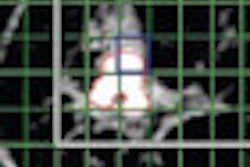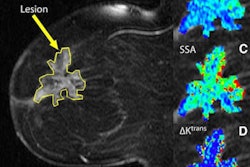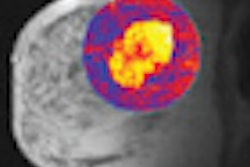Breast MRI's sensitivity is superior to that of mammography in long-term screening for women at risk of breast cancer, according to a new study in the Journal of Clinical Oncology. What's more, the study showed that breast MRI improved survival rates by almost 20% when compared to women tracked in earlier research.
The finding is good news for women with cumulative lifetime breast cancer risk, offering the option of breast MRI surveillance instead of prophylactic mastectomy.
Women at risk for breast cancer due to genetic predisposition have a cumulative lifetime risk between 15% and 85%, according to lead author Adriana Rijnsburger, MD, of Erasmus University Medical Center in Rotterdam, the Netherlands. This risk is often reduced by prophylactic surgery or chemotherapy, but these are dramatic strategies.
Using breast MRI to follow high-risk women offers a less invasive way to track women who are susceptible to breast cancer (J Clin Oncol, November 15, 2010). And Rijnsburger's team found that after six years of follow-up, 93% of mutation carriers tracked with MRI were still alive, compared with 74.5% at five years in earlier studies.
Most guidelines recommend breast MRI screening in women who carry BRCA1 or BRCA2 mutations. There has been no agreement on screening protocol for other at-risk populations, however. To investigate this question, Rijnsburger and colleagues extended the Dutch MRI Screening Study (MRISC), following 2,157 women for five years.
The study included women who had never had breast cancer, but who had a cumulative lifetime risk of developing the disease of at least 15%, due to familial or genetic predisposition. The women were divided into three groups: those who carried BRCA1, BRCA2, or other mutations, which upped their risk to the range of 50% to 85%; a high-risk group with 30% to 50% cumulative lifetime risk; and a moderate-risk group with 15% to 30% risk without any known genetic mutations.
The women were given biannual clinical breast examinations, and annual two-view mammography and MRI exams (performed on a 1.5-tesla system by Siemens Healthcare of Erlangen, Germany). During the study time frame, all the participating centers switched from conventional to digital mammography.
Rijnsburger's team found 97 cancers in 94 women, 78 of which were invasive (80%) and 19 of which were ductal carcinoma in situ, or DCIS (20%). MRI's sensitivity at detecting breast cancer was 70.7%, which was greater than mammography's at 41.3%. When the team considered only invasive cancers, MRI's sensitivity increased to 77.4%, while mammography's sensitivity decreased to 35.5%.
When the researchers considered only genetic mutations, MRI's sensitivity once again bested that of mammography, particularly in BRCA1 carriers, at 66.7% compared to 25%. The two modalities' sensitivity with BRCA2 carriers was more comparable, with MRI at 69% and mammography at 61.5%. Rijnsburger's team attributed this difference to the higher prevalence of DCIS in BRCA2 carriers compared to BRCA1 carriers; mammography is more sensitive than breast MRI in detecting DCIS (69.2% compared to 38.5%).
The two modalities' specificity was comparable, the team found.
The researchers also determined that 42.7% of breast cancers overall were detected only by MRI screening, including 45.8% of the cancers in BRCA1 carriers, 30.8% in BRCA2 carriers, 40.9% in high-risk women, and 46.7% in moderate-risk women. These findings suggest that not only should breast MRI be used for annual screening in women with BRCA1 and BRCA2 mutations, but for all women with a 20% to 25% or greater cumulative lifetime risk of breast cancer due to family factors.
Over the five years of the study, cumulative distant metastasis-free and overall survival was 83.9% for BRCA1 mutation carriers and 92.7% for BRCA2 mutation carriers; women in the other at risk groups had a 100% survival rate, according to the authors.
By Kate Madden Yee
AuntMinnie.com staff writer
November 17, 2010
Related Reading
Breast MRI shows high negative predictive value in BI-RADS 3 lesions, November 10, 2010
Preoperative breast MRI doesn't increase mastectomy rates, November 10, 2010
Breast MRI shows high negative predictive value in BI-RADS 3 lesions, November 9, 2010
Community facilities follow breast MRI rules, November 1, 2010
DWI-MRI improves breast MRI's accuracy at 3 tesla, June 24, 2010
Copyright © 2010 AuntMinnie.com



















